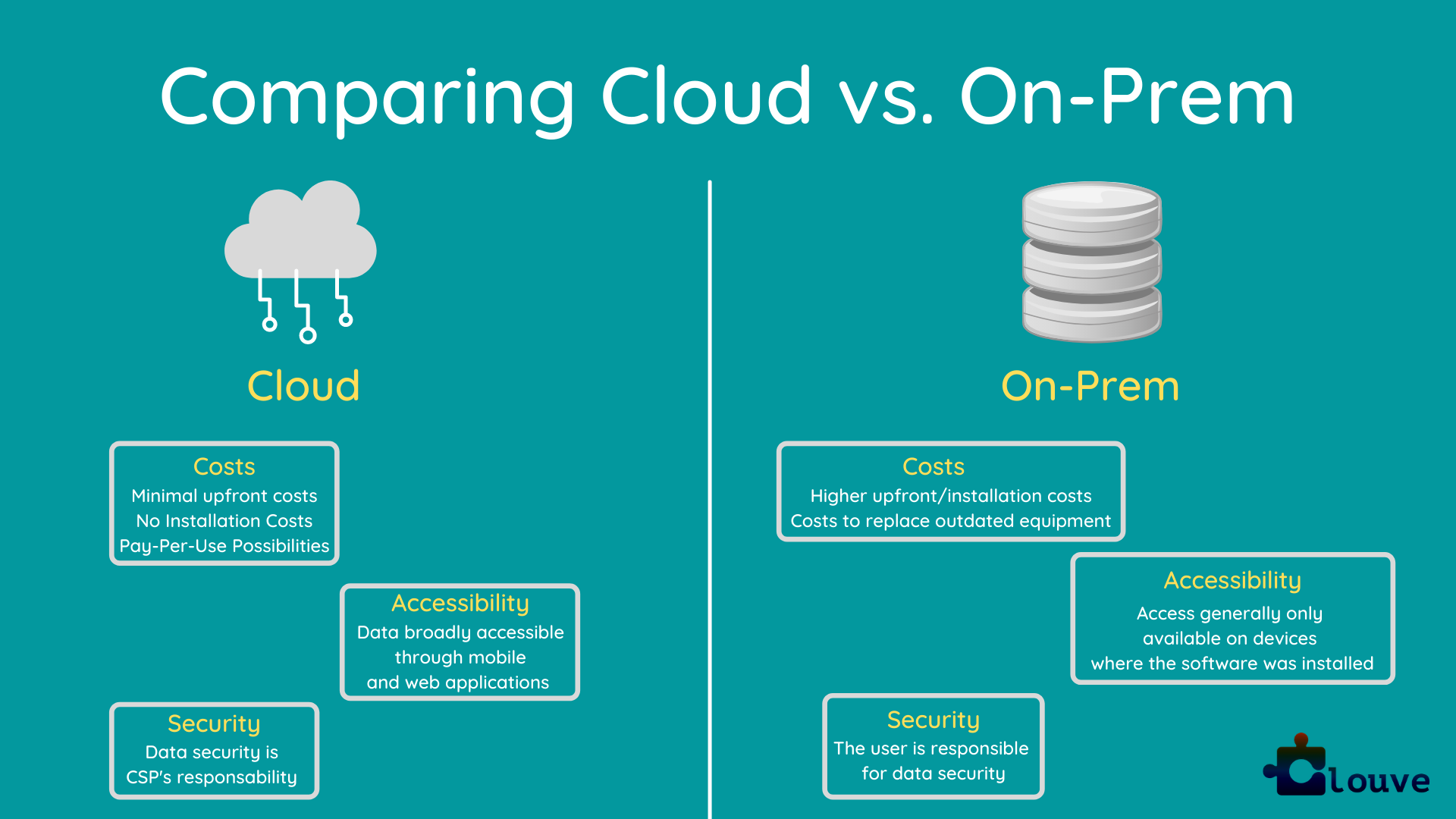To move to the cloud or remain on-premises? That is certainly the key question that bothers many companies as they ponder on how to most efficiently manage their databases.

With data becoming the very center of business operations, organizations are more closely focusing on how they choose to store, manage and process this key asset.
Firms that struggle to find the right fit for their data needs often find themselves struggling or falling behind their competition simply because they are unable to meet the expectations of their customers.
Many enterprises fail to leap into the cloud and instead rely on their on-prem infrastructures and applications. An even greater number of organizations, however, are migrating their applications to the cloud every year. Major service providers such as Google Cloud, AWS, and Microsoft Azure have all experienced huge growth.
But is the cloud always the optimal solution? On-prem tools might not be the best option for a majority of businesses, but in particular scenarios, this type of infrastructure might work better for database hosting and management.
In this article, we will look into both of these solutions, list their main differences and multiple pros and cons in addition to other factors you should keep in mind as you decide which option is the best fit for your enterprise needs.
The On-Prem Solution
On-premises are usually defined as a combination of hardware and software infrastructural setup that is both deployed and ran within the confines of your organization’s premises.
In this scenario, the user has full control over the infrastructure. That’s because your data stays within your private network, with your IT team being the only one with access to the database.
We’ve discussed on-prem so much during our past posts, you might want to take a look at some of them here, and here.
Whether an organization decides to keep its applications on-prem or in the cloud, data security will always be of crucial importance.
For some businesses that operate in highly regulated industries, deciding might be easy. Having all data located within organizational servers and IT infrastructure without any third parties can be a deciding factor in those scenarios.
However on-prem environments also have drawbacks, mainly associated with costs of management and maintenance, which usually run significantly higher than with cloud computing solutions.
On-prem setups require extensive amounts of software licenses, hardware, equipment, and of course, IT staff to support and manage any issues that may arise.
The Cloud Solution
While the on-prem environment entails in-house hosting by the user, a cloud environment features a third-party provider taking on this responsibility.
This allows organizations to efficiently scale up or down depending on their overall usage and growth, in addition to conveniently paying for services on an on-demand basis.
Thanks to virtual technology, cloud-based servers are capable of hosting users’ applications offsite. This translates into no capital expenses whatsoever, as well as an ability for companies to regularly backup data, and only pay for resources that they use.
A cloud environment is especially appealing to organizations that plan global expansion, as this kind of technology allows businesses to connect with customers and partners seamlessly and efficiently.
In addition to that, cloud computing offers instant provisioning due to everything already being fully configured. Hence, new software that integrates into your environment will be ready to use right after your business has subscribed.
Instant provisioning eliminates time spent on configuration and installation, allowing users to access their applications immediately.
Cloud Vs. On-Prem Servers: Key Differences
Both of these environments bring unique advantages to the table, however, you won’t be able to determine which solution is the right fit for your business unless you spend time closely studying both.
Some of the key differences that weren’t already discussed above and that you might want to analyze before choosing between on-prem and cloud are:
Cost
On-Prem: Setting up hardware infrastructure requires a hefty initial investment, in addition to ongoing equipment replacement expenses. Not to mention maintenance and operating costs that organizations incur regularly.
Cloud Computing: In comparison to the on-prem solution, a cloud service is certainly more cost-effective in the majority of cases. Setting up, running, and maintaining your cloud infrastructure is significantly faster and cheaper.
Despite this, it’s important to note that in some scenarios the costs of both solutions might not be that different at all. For instance, on-prem infrastructure requires higher initial investments but, if spread over the full life cycle of the system, the costs are similar to the ones incurred in some cloud infrastructures.
Essentially, it all comes down to the needs of individual organizations – that is, the specific services and space required by businesses, and the variety of cloud service plans offered by their vendors.
Security
On-Prem: Data security is one of the most essential requirements of any enterprise that deal with customer and staff information.
A traditional on-prem environment is generally regarded as more secure due to it being within organizational boundaries, that is, in-house.
However, there are still multiple measures and strategies that companies need to undertake to fully maintain the security of their databases in these scenarios.
Cloud Computing: Cloud ERP systems present very low risks of software or hardware malfunction that can result in hefty data loss.
As organizations opt to move to the cloud, their data security concerns are fully taken over by cloud service providers, which provides a level of convenience and comfort.
Mobility
On-Prem: Third-party support is required to access on-prem ERP systems via mobile devices or remotely in most cases. This sometimes negatively affects productivity and efficiency within the organization.
Cloud Computing: A cloud environment certainly offers more flexibility and mobility in this case. Data can be securely accessed through any device, with a strong internet connection in place.
This feature allows company staff to be employed remotely, resulting in higher productivity and engagement.
Hybrid Cloud
A popular approach used by many companies is a hybrid cloud.
A hybrid cloud is a solution that provides organizations with a combination of on-prem, public cloud, and private cloud services. Hybrid offers much flexibility as it allows workloads to shift between public and private clouds at times when costs and capacity fluctuate.
Enterprises usually host their most sensitive data and applications in a private cloud, while placing their most critical workloads in public clouds.
The main benefit that hybrid cloud has to offer is increased agility. Since organizations have a strong need to adapt to changes and alter directions accordingly, some of them might want to mix private clouds, public clouds, and on-prem resources to acquire the agility that would lead to a stronger competitive edge.
While cloud adoption is currently widespread, many businesses have their reasons to stay within their on-prem infrastructures or use a combination of both. Risk mitigation, control, and cost are some of the main drivers in the cloud vs. on-prem discourse.
For enterprises that operate at a higher scale, a hybrid cloud model offers the flexibility to use public cloud services during high usage periods without the need to invest in additional infrastructure.

A brief outlook onto some of the pros and cons of each solution are as follows:
Cloud Storage – Pros
- No capital investments
Cloud storage is an operational expense as opposed to on-prem which is considered a capital investment.
Because cloud storage is fully taken care of outside of the organization’s premises, there is no need for hefty capital expenses, making this option attractive to many.
- Regular Backups
It’s easier to backup data on the cloud than on-prem. Cloud-based servers offer the convenience of seamless access to the information, allowing users to minimize risks of data loss as well.
- Scalability
Cloud computing technologies are built to scale up and down depending on users’ specific needs. To do so, companies would only require to upgrade or downgrade their plans at any point in time. And because cloud services are provided on a subscription basis, making these changes doesn’t require lengthy processes.
- Deployment
Deployment of cloud software can be done in a matter of days or even hours, due to internet connectivity.
- Security
The security measures provided by CSPs are in most cases significantly superior to those maintained by companies on-prem.
Cloud – Disadvantages
- Internet Dependency
One of the main drawbacks of using cloud storage is its dependency on a reliable and fast internet connection. If, for instance, the connection is slow, accessing data and files can become a challenging experience.
- Third-Party Concerns
When companies migrate to the cloud, they entrust their data and applications to be managed and hosted by cloud service providers. This might pose some risks, like unauthorized access and data loss.
To avoid issues like these, it is recommended to discuss security procedures and practices, as well as methods of encryption of data in transit and at rest with your cloud vendor before you make your cloud move.
On-Prem – Advantages
- No Internet Dependency
One of the strongest advantages of on-prem storage is certainly the fact that users are not required to have an internet connection to access their data.
That being said, most businesses still rely on the World Wide Web to conduct operations at this time and age. What differentiates on-prem from a cloud solution is its provision with an internal network that is widely accessible without an internet connection.
- Greater Security
Unlike a cloud environment, where users are somewhat vulnerable to third parties, on-prem storage is fully restricted and is only accessible by authorized personnel.
The data stays protected and inaccessible to those outside the internal network in part because it’s not stored online.
An on-prem infrastructure might be a great option for businesses that handle extremely sensitive data, like those in the financial sector.
- Control Over Server Hardware
An obvious advantage of an on-prem solution is the total autonomy that it offers its users. Companies upgrade their servers by themselves, instead of having to go through a service provider every time. The ability to modify servers’ hardware can provide businesses with greater customization and flexibility for their storage needs.
On-Prem – Disadvantages
- Extra IT Support Costs
On-prem infrastructure requires extensive investments in human resources. Naturally, you will need IT staff to manage and maintain your servers.
The extra expenses of hiring, training, and employing additional team members can hence take a significant toll on your company’s budget.
- Industry Compliance
Unlike a cloud environment, where the responsibility to comply with government regulations rests mostly on the shoulders of the service provider, things are a little different for those operating on-prem.
If your business falls within a strictly regulated industry such as health care or finance, it is fully your responsibility to abide by the regulations put forward by local and federal authorities.
And from expenses on audits and potential fines to extra duties that your employees would have to take on – compliance can surely become costly in the long-run.
- Low Scalability
One of the drawbacks of an on-prem environment is its limited scalability. As a company’s needs change with more or less storage space required, most businesses find it challenging to scale their on-prem servers quickly enough.
That’s because on-premises storage requires users to install new hardware and invest in manpower to build new systems, as opposed to a cloud-storage where companies can simply select plans that suit them best.
Migrating From On-Prem To The Cloud: What You Should Know
A growing number of businesses are actively migrating their data and applications to the cloud mainly because of several limitations seen within the traditional on-prem environment.
If you’ve decided to jump on the bandwagon too, there’s certainly a lot to keep in mind during your migration journey.
Foremostly, this strategic decision comes with its own set of challenges and hence must align with the rest of your organizational processes to be successfully implemented.
Data migration is one of the most challenging parts of your cloud migration journey. The location of a company’s data has the power to significantly affect the performance of its applications, and moving data to the cloud when data access methods are still on-prem can also impact that same performance.
Some strategies for data migration are:
- Establishing and using a bi-directional syncing mechanism between your cloud and on-prem databases. You can then remove the on-prem database once you have successfully moved all the data to the cloud
- Using an on-prem database with a one-way syncing mechanism to a cloud-based database, allowing your consumers to only connect to the on-prem version. Further on, you can disable access to the on-prem version and establish your cloud-based version as the main database
- Using an expert cloud data-migration service
Whatever route you choose in planning for your data move, ensure to not underestimate the complexity and importance of this process.
Failing to invest adequate time and energy into your migration plan might result in your cloud adoption journey failing to meet your company’s expectations.
And remember, whether you’re moving on your own, or using the help of professional cloud experts, ensure to understand well what solution makes the most sense for your implementation!
Why Clouve?
Because deploying your IT department to the cloud should be affordable.
Clouve is a subscription-based platform that makes it easy for businesses to use cloud expert services, tools, and support cost-effectively.
See how Clouve works for your business. Sign up today for a 90-day free trial, no commitments.
